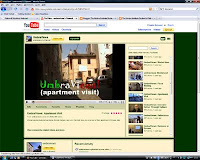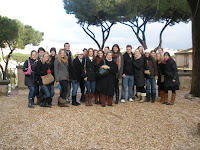Last weekend, 37 Umbra students in Professor Bevagna’s Roman Civilization course spent three days exploring the rich archaeological heritage in the Naples area of Italy. Despite temporary museum closing due to protests, unusually rainy weather, and the famous Napolitan traffic, the trip was a total success and the group was able to visit the ruins at Pompeii, the Villa Oplontis, and Herculaneum, all of which were preserved in time by volcanic material when Mount Vesuvius erupted in 79 AD.
Month: February 2010


Students may not have realized just how lucky they were to see snow falling in Rome… it was the first snowfall in the Holy City since 1986!
 Four years ago Erin Jordan came to Italy and the first thing she ate was gnocchi, Italy’s potato and flour reponse to knoedel. At the Arrival Dinner on her first night in Perugia, Jordan sat down to the table with all her fellow students and had…gnocchi. It seemed only natural then that, when asked to write about an Italian food by her creative writing professor, Erin chose gnocchi.
Four years ago Erin Jordan came to Italy and the first thing she ate was gnocchi, Italy’s potato and flour reponse to knoedel. At the Arrival Dinner on her first night in Perugia, Jordan sat down to the table with all her fellow students and had…gnocchi. It seemed only natural then that, when asked to write about an Italian food by her creative writing professor, Erin chose gnocchi.
“Write what you know,” is the old adage, so Erin decided to cook first, write later. A low-cost yet filling alternative to dinner out at the ristorante, gnocchi combine simplicity (potatoes, flour, salt) with versatility: like other kinds of pasta, they lend themselves to combination with practically any kind of sauce. Perennial Italian favorites are melted butter and sage or a simple tomato sauce, but gnocchi are forgiving, though not a quick meal.
Jordan, with the help from her roommates, spent about two hours peeling, boiling, and mashing the potatoes, then mixing in the flour and salt, rolling out the long cylinder of dough, and cutting up the gnocchi. The time was worth it, though, as the meal was delicious, providing not only nourishment but a perfect point of departure for Jordan’s creative writing assignment.
Complimenti and buon appetito!

This and other olive oil-drenched food history nuggets were the main course last night at the Umbra Institute pizza workshop, aside from the pizza, of course. Students went to the almost-hidden Pizza & Musica pizzeria (on Perugia’s “Best of..” list!) and not only ate pizza but made it too. Three students got to pull the dough out, add toppings, and then actually spin it in the oven. The next workshop will be on February 16th, sign up soon!
The Umbra Institute offers a wide range of options for learning Italian.
Io sono, tu sei, lui è… Learning a language isn’t just about learning the conjugation of a verb, it’s about experiencing a culture. At the Umbra Institute, though, we know that there are many reasons for learning Italian, and so we offer a variety of approaches.
During the Fall and Spring semesters, students who follow the General Studies track take most of their classes in English but have one obligatory language and culture class. This can be either the four credit-hour course or the six-credit intensive Italian course, designed to give the student even more contact with the grammar and vocabulary.
For students who would like to concentrate completely on the language, there are two different language immersion programs. During the Fall and Spring semesters, students can choose to have their lessons at the University for Foreigners, a world-famous school for university level Italian instruction. When taking classes through the Umbra Institute students will receive credits transferable to their home institution. In the summer months the immersion option is the Intensive Italian Through Culture program, directed by Professor Robert Proctor of Connecticut College. Much like the Full Immersion program at the University for Foreigners, this course is taught entirely in Italian and provides a quantum leap for those studying the language more seriously.
Io vengo, tu vieni, lei viene… We hope you’ll come to the Umbra Institute, where learning Italian isn’t simply learning the language, it’s living Italy.





